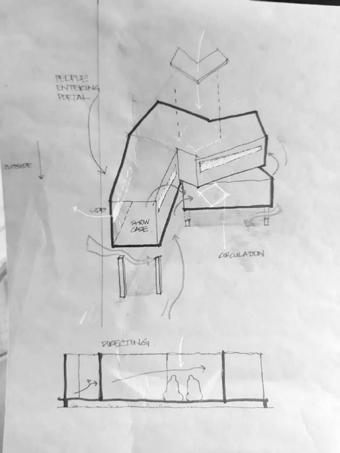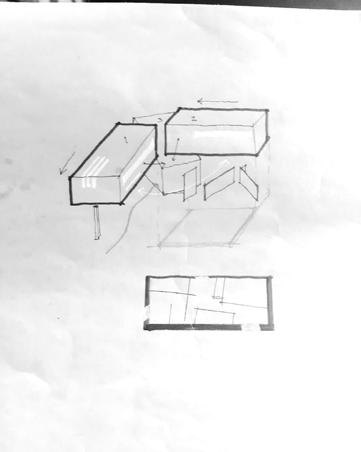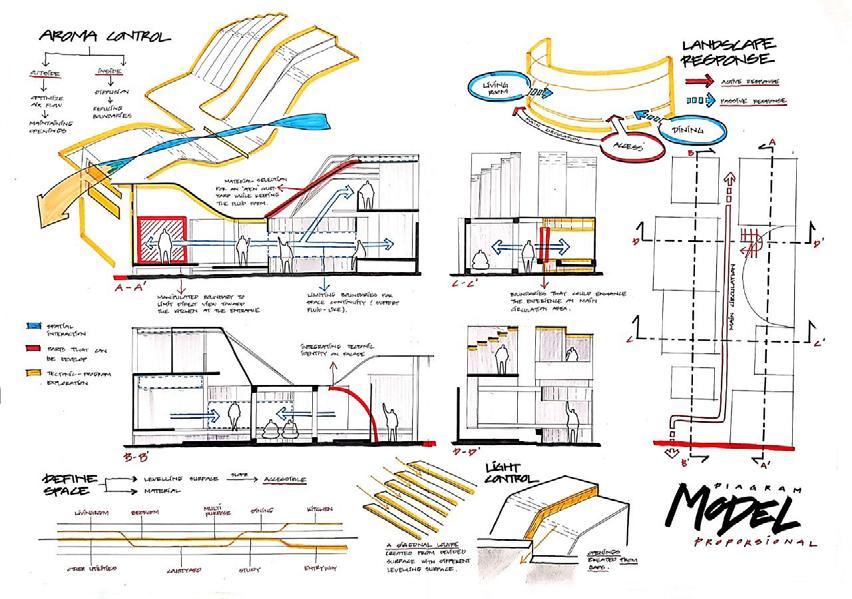
5 minute read
The Inside of the Process
This section presents the inside of the design process conducted in the exploration of dwelling spatial ideas in this design studio. Design is a conceptual process that involves both divergent and convergent thinking styles; thus, the design process is not only creative and exploratory but also evaluative and analytical (Plowright, 2014). Looking into the inside process may reveal the interplay between such creative and rational approaches performed along the design process (Harahap et al., 2019), and how the final design could emerge as an integration of these two approaches in parallel.
The process of reflection becomes the key in the construction of design knowledge by the students as they go along these stages of developing their design ideas. The selected written reflections by the students, as well as some diagrams they produced during different learning stages, convey the process of acquiring various forms of design knowledge and skills. Such acquisition of knowledge and skills happens through the continuous learning acts of investigating, analysing, making and exploring, which are simultaneously reflected and integrated.
Advertisement
--Bella Putri Muliana--

“Creating harmonies with program and tectonics at first is difficult. By time, the idea is developing by learning using models .Identity of the house also developed by models and diagrams. I also learn about prioritize the interiority of the space itself. Atmosphere and interiority quality is
exist by itself, not by adding too much things to the
space. Creating atmospheres is really important to also support the program.” --Shafira Azzahra-- “Unique characteristics of the family might become an opportunity to develop a specific and rich scenario. The
dwelling scenario should incorporate the ideas of growth as a part of everyday living of the family, with spatial implications not only for the present but also for
further years.” --Yohanna Anindya Budi P.-- “The fun (or rather, the “fun”) in designing a dwelling comes with the long and intricate process of exploring new possibilities of ways to enhance the dwellers’ lives at home. Ideating the
“what ifs” is one thing, but exploring whether or not those “what ifs” match clients’ needs is another thing, and that is what makes the whole process challenging, although it makes for a
worthwhile discovery.” --Reyna Ananda Harsono--

Th e Tsh ei t e
Exi s ti n g house App App roro a c h (aecsh () e s )
--Kelvin Andrean--
“Designing process doesn’t go one way. In designing, it is certain that the process will go (tirelessly) back and forth due to adjusting every time a new idea is presented in the design and it is definite that all the steps happen simultaneously in the end. Regardless, we must always try to explore all the possibilities to advance our design. And the idea is not to build a ‘new’ home for the clients, but rather having the clients' term of "home" amplified.”

--Lintang Kirana SItaputri--


F o c uu s ed s ed problemproblem s i t e

Activities Activities What ma Wkes hat makes
Hobbies Hobbies their curre tnht eir current What Analysis Physical co P n h d ys iti ica on l condition home t hom h e e hir ome t hom h e eir m th ake em s
How they i How nhab they i it the nhabit the unique? current ho currme ent home What makes them unique?
Qualities Qualities
P ro P ro g rammag ramma t i c t i c
Design a Design a speci speci c program c program tha that responds t responds to the focu to se t d he foc issue u b se ut d issue but also acco also accommo mmodate them da as te them a family as (n a family ot as sep (n ar ot as ate in separa dividu te in als) dividuals)
--Adika Ramaghazy-- --Alya Hasna Rizky Riandita--
HOW HOW Determini Determin ng spatial ing voc sp ab a u tial v lary ocabulary
Te c t Te c o n i t c o n i c
At m A o t m o s p s p h e r i h c e r i c
Interior de Int tail erio ing r detailing
Re nemen R t e nemen S t ize adjustSimze adjents ustments Basic Mod Ba els sic Mod explora e ti ls e on xploration
REDO basi REDO c mod b el asic model
More expl Mo orat re exploration ions (identity s (identity + program + ) program) The modelThs de moidn’tdels dshow idn’t shbendinow beng at all ding at all
(-) identity! (-) identity!
(-) respond (-) to resp the on iss d u t e o the issue
Tectonic st Tectoni atemen c t s tatem naliza ent tion: nalization: Contrast s Contr urface ast surfac bending e bending Reduce Reduce unnecessa unn ry el ecessa ement ry s elements Remembe Remem r: interio b ri er ty : ! interiority!
More expl Mo orat re explorations ions (materials) (m & aterials) & developm de ent v s elopments Developm De ent vel : In opmen side-ou t: ts I i n d si e de-outside relation relation
e TFhi en aFl i nD a le s iDge sn i g n
--Alya Hasna R. R.-- “A good design is the one that can fulfill the needs of its user. Every room has to have different criterias and needs. Those different needs are the ones that determine the quality of the interior, ambience, and its atmosphere.” --Layla Dutha Faradiba--

“From my experiment, I have been given multiple insight of new shape usage and, of course, from that I have created a unique tectonic that while I am in my research at the internet, I found nothing like it. It means that there is so much
potential in design that we dont see and
we can create in the future on.” --Christopher Christian Surya--






